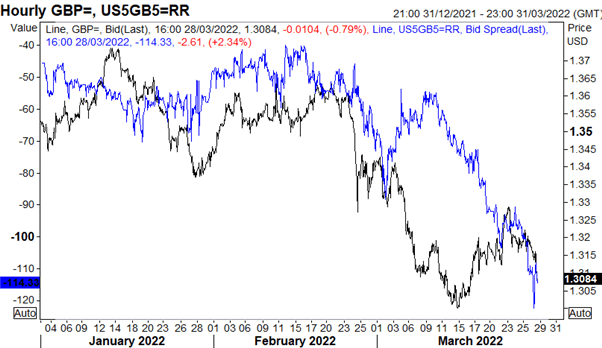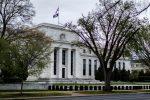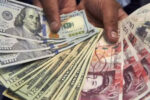Pound forecast: Will the pound fall further

Will the pound fall: Despite the Bank of England hiking at the fastest pace in over a decade, Cable is on course for its worst quarterly performance since Q1 2020. Looking ahead to Q2, I lean towards a bearish GBP stance against commodity currencies and currencies backed by increasingly hawkish central banks such as the USD.
GBP/USD CAN BREAK BELOW 1.30
As the UK heads towards the biggest squeeze on incomes in a generation, the BoE has become increasingly cautious over downside growth risks. So much so that they have slightly tweaked their forward guidance, suggesting a possible pause in their hiking cycle. This is despite inflation pressures picking up. I believe there is a chance this happens when the bank rate is at 1%. However, should this not be the case, money markets are still far too aggressive relative to the BoE’s growing reluctance to continue raising rates, given the current trade-off between slowing growth and rising inflation pressures. In contrast, at the Federal Reserve, Powell and Co. are warming up to the idea of back to back 50bp rate rises in May and June, alongside quantitative tightening in order to return to neutral as quickly as possible. In turn, rate differentials are moving in favour of the USD.
US/UK 5YR BOND SPREADS

That said, areas to fade GBPUSD would be on relief rallies to 1.3200-50, looking for a move towards 1.2750-1.2800. The bearish outlook would be invalidated on a close above 1.3450.
The pound sterling (GBP) foreign exchange (forex) rate against the US dollar has been in a downward trend for much of the past year and threatens to drop below the $1.30 level for the first time since October 2020.
What macroeconomic factors account for the prolonged weakness in the value of the GBP? We look at the pound’s performance over the past year and the latest projections from analysts as well as the latest GBP news.
British pound forecast: what drives the UK currency?
The pound’s value is driven by macroeconomic factors such as the performance of the UK economy, the balance of trade, inflation and interest rates, which affect demand for the currency. The Russia-Ukraine conflict has driven up already-high energy prices, further increasing inflation in net importers including the UK, where inflation stands at 6.2%. That is well above the Bank of England’s (BoE) long-term 2% target and weighs on expectations for the UK’s economic growth.
On 16 March, the central bank’s Monetary Policy Committee (MPC) voted by 8-1 to increase the Bank Rate by 0.25 percentage points to 0.75% in a bid to tackle the rate of inflation. According to the meeting minutes:
“In the MPC’s central projections in the February Monetary Policy Report, published before Russia’s invasion of Ukraine, UK GDP [gross domestic product] growth was expected to slow to subdued rates during the course of this year. This in large part reflected the adverse impact of the previous, already large, increases in global energy and tradable goods prices on UK real aggregate income and spending.
“Developments since the February Report are likely to accentuate both the peak in inflation and the adverse impact on activity by intensifying the squeeze on household incomes.”
The Russia-Ukraine crisis has lifted prices for other commodities as well as energy, including food prices. It’s likely exacerbating disruption to the global supply chain caused by the Covid-19 pandemic. The MPC noted that it has increased economic uncertainty “significantly”. That adds to uncertainty about the GBP future performance.
Will the pound get stronger in 2022?
A prolonged period of high energy prices could push the Consumer Price Index (CPI) inflation around the end of 2022 above the 7.2% projected for April, which had been expected to be the peak. That would have a further adverse impact on UK real aggregate income and spending. “This is something monetary policy is unable to prevent,” the MPC added.
The GBP/USD exchange rate climbed to the $1.42 level in May 2021, its highest level in five years. But sterling subsequently turned lower and has since been in decline. The currency ended 2021 at $1.35, sliding to the key $1.30 psychological level in mid-March.
What is the outlook for the GBP/USD currency pair in light of the challenges posed by high inflation and slowing economic growth?

Have a confidential tip for our reporters?
The pound sterling (GBP) foreign exchange (forex) rate against the US dollar has been in a downward trend for much of the past year and threatens to drop below the $1.30 level for the first time since October 2020.
British pound forecast: what drives the UK currency?
The pound’s value is driven by macroeconomic factors such as the performance of the UK economy, the balance of trade, inflation and interest rates, which affect demand for the currency. The Russia-Ukraine conflict has driven up already-high energy prices, further increasing inflation in net importers including the UK, where inflation stands at 6.2%. That is well above the Bank of England’s (BoE) long-term 2% target and weighs on expectations for the UK’s economic growth.
Will the pound fall
Will the pound fall: On 16 March, the central bank’s Monetary Policy Committee (MPC) voted by 8-1 to increase the Bank Rate by 0.25 percentage points to 0.75% in a bid to tackle the rate of inflation. According to the meeting minutes:“In the MPC’s central projections in the February Monetary Policy Report, published before Russia’s invasion of Ukraine, UK GDP [gross domestic product] growth was expected to slow to subdued rates during the course of this year. This in large part reflected the adverse impact of the previous, already large, increases in global energy and tradable goods prices on UK real aggregate income and spending. “Developments since the February Report are likely to accentuate both the peak in inflation and the adverse impact on activity by intensifying the squeeze on household incomes.”
The Russia-Ukraine crisis has lifted prices for other commodities as well as energy, including food prices. It’s likely exacerbating disruption to the global supply chain caused by the Covid-19 pandemic. The MPC noted that it has increased economic uncertainty “significantly”. That adds to uncertainty about the GBP future performance.
Will the pound get stronger in 2022?
Will the pound fall: A prolonged period of high energy prices could push the Consumer Price Index (CPI) inflation around the end of 2022 above the 7.2% projected for April, which had been expected to be the peak. That would have a further adverse impact on UK real aggregate income and spending. “This is something monetary policy is unable to prevent,” the MPC added.
The GBP/USD exchange rate climbed to the $1.42 level in May 2021, its highest level in five years. But sterling subsequently turned lower and has since been in decline. The currency ended 2021 at $1.35, sliding to the key $1.30 psychological level in mid-March.
What is the outlook for the GBP/USD currency pair in light of the challenges posed by high inflation and slowing economic growth?
Will the pound go up or down?
Will the pound fall: Technical analysis shows that the $1.30 level is key and a drop below it opens the way for further decline.
Analysts at Scotiabank viewed the short-term GBP trend as bearish. In their GBP forecast on 7 April they wrote:“Sterling’s multiple failures to break firmly through 1.31 during yesterday’s session and through overnight trading has left the GBP trading in a narrow channel over the past two sessions. The mid-figure area marked the bottom yesterday, with the overnight low of 1.3063 acting as intermediate support before this zone—which held up twice during yesterday’s session. A drop below the mid-1.30s leaves the GBP at clear risk of testing the 1.3000 low of mid-March after which point only the next figure level stands as psychological support. Resistance past 1.3100/10 is the 1.1350 area and ~1.3165.”
The moving average convergence divergence (MACD) and directional movement indicator (DMI) showed sell signals, while the nine and 21-day moving averages showed buy signals. The Relative Strength Index (RSI) was 38, putting it close to oversold territory below 30, Scotiabank’s analysis showed.
Market sentiment:

According to Citibank’s weekly commentary:
Will the pound fall:“Russia-Ukraine tensions have weighed on cable through the terms of trade shock to the UK. Meanwhile, the UK’s inflation (and expectations) outlook seems to be more elevated and sustained. Citi thinks the BoE would likely pause or at least slow down the pace of 25bps rate hikes to one per quarter up to a maximum rate of 1.5% by 22 November. “The better pairing to express near term BoE hawkishness remains via a long GBP versus funders (EUR, CHF and JPY). Against USD however, sterling is likely to range –trade with 1.32 – 1.38. GBPUSD is now below the pivot at 1.3358 and has also broken through next support at 1.3135-63 – which supports even lower levels.”
Societe General analyst Kit Juckes noted in a recent analysis that the GBP/USD rate tracks the differential between UK and US 10-year treasury yields “remarkably well, which is a problem for sterling.” The chart “suggests that unless the US bond sell-off runs out of steam very fast, GBP/USD 1.30 is going to break.






